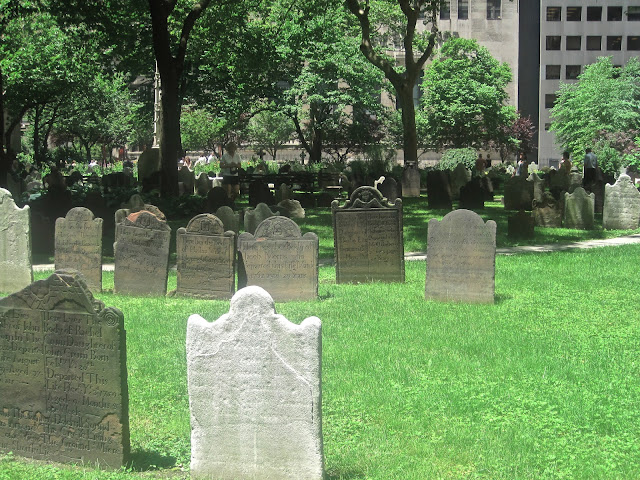Historians James Deetz and Edwin Dethlefsen, in their groundbreaking study in the 1960s, identified the tripartite iconographic system of New England gravestones: death's head, cherub, urn & willow. Death's head is the oldest tradition and, frankly, the coolest. In many ways, New Englanders of the seventeenth century were still living in the Middle Ages, and the death's head definitely has a medieval feel to it. A couple of weeks ago, I went to Trinity Church Cemetery on Wall Street, where you can find examples of seventeenth- and eighteenth-century gravestones with death's heads right in the shadow of skyscrapers.
Like this one. Check out its curly eyebrows. So. Awesome.

And this one, from 1691:

And this one ... okay, now that's a cherub. You can see how the cherub face evolved out of the death's head, though. For one, the wings are the same. This is actually a later cherub. Earlier ones would have shown closer stylistic affinities with the death's head, preserving its shape and the ghosts of its features. The spirals are still there, though, symbols of eternity.
It wasn't until the nineteenth century that people in New York thought to bury people somewhere other than the middle of town. With urban development, immigration, epidemics, and the filth of industrialization came the realization that it might not be a good idea to have dead bodies in the middle of the city. Green-Wood Cemetery in Brooklyn, founded in 1838, was one of the first rural cemeteries in the U.S. (meaning, it was intentionally positioned in a rural, out of the way location).

Throughout the nineteenth and twentieth centuries, many of Manhattan's cemeteries were destroyed. Bodies were either exhumed and reburied elsewhere or simply left in place while their stones were removed. Not Trinity Cemetery, though, nor its sister cemetery at St. Paul's Churchyard. Those are still here today. Some of the stones at St. Paul's were blasted apart in the 9/11 terrorist attacks, and had to be put back together.
Today the only cemetery in Manhattan that accepts new burials is Trinity Cemetery in Washington Heights, the sister cemetery of Trinity Cemetery Wall Street, which was established when burials were outlawed in Lower Manhattan in the mid-nineteenth century. I think there are six or so plots available, so you have a spare $20,000 hanging around and would like to be buried in the same cemetery as John Jacob Astor, you'd better hurry up and make the arrangements.





I am developing a guided walking tour of NYC’s Financial District. It will included Trinity Church & its churchyard. Your blog posting here has been helpful. I also offer the Gay Graves Tour [http://walkaboutny.com/the-tours/the-gay-graves-tour/] at Green-Wood Cemetery, a National Historic Landmark in Brooklyn.
ReplyDeleteWhat is sad is the old St John's Cemetery in Greenwich Village that was taken by the city to construct Hudson Park, today know as James J. Walker Park. Only a handful of the bodies and stones were removed, most were left behind. https://nycemetery.wordpress.com/2011/01/04/st-johns-cemetery/
ReplyDelete